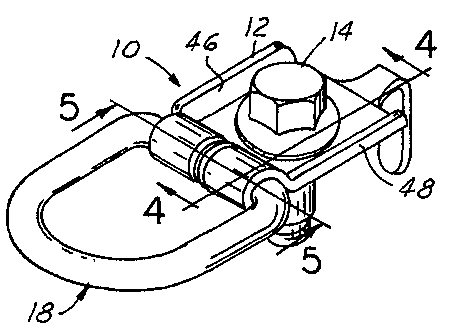Une partie des informations de ce site Web a été fournie par des sources externes. Le gouvernement du Canada n'assume aucune responsabilité concernant la précision, l'actualité ou la fiabilité des informations fournies par les sources externes. Les utilisateurs qui désirent employer cette information devraient consulter directement la source des informations. Le contenu fourni par les sources externes n'est pas assujetti aux exigences sur les langues officielles, la protection des renseignements personnels et l'accessibilité.
L'apparition de différences dans le texte et l'image des Revendications et de l'Abrégé dépend du moment auquel le document est publié. Les textes des Revendications et de l'Abrégé sont affichés :
| (12) Brevet: | (11) CA 2398830 |
|---|---|
| (54) Titre français: | DISPOSITIF DE RETENUE DE CHARGE |
| (54) Titre anglais: | CARGO RESTRAINT DEVICE |
| Statut: | Durée expirée - au-delà du délai suivant l'octroi |
| (51) Classification internationale des brevets (CIB): |
|
|---|---|
| (72) Inventeurs : |
|
| (73) Titulaires : |
|
| (71) Demandeurs : |
|
| (74) Agent: | MACRAE & CO. |
| (74) Co-agent: | |
| (45) Délivré: | 2008-01-15 |
| (86) Date de dépôt PCT: | 2001-02-21 |
| (87) Mise à la disponibilité du public: | 2001-08-30 |
| Requête d'examen: | 2005-11-22 |
| Licence disponible: | S.O. |
| Cédé au domaine public: | S.O. |
| (25) Langue des documents déposés: | Anglais |
| Traité de coopération en matière de brevets (PCT): | Oui |
|---|---|
| (86) Numéro de la demande PCT: | PCT/US2001/005631 |
| (87) Numéro de publication internationale PCT: | US2001005631 |
| (85) Entrée nationale: | 2002-07-29 |
| (30) Données de priorité de la demande: | ||||||
|---|---|---|---|---|---|---|
|
Une retenue de charge a un anneau en forme de D (18) doté de portions d'extrémités opposées (26, 28) frappées à froid, légèrement séparées, coincées dans un trou d'une voie de passage (40) d'un point d'ancrage et tendues contre les bords du trou afin d'éviter le bruit et le retrait des extrémités de l'anneau en D (18) hors dudit point.
A cargo restraint has a D-ring
(18) with cold-headed opposed end portions (26,
28) spaced slightly apart and trapped in a gap
in a passageway (40) of an anchor bracket and
tensioned against edges of the gap to prevent
rattling and withdrawal of the ends of the D-ring
(18) out of the bracket.
Note : Les revendications sont présentées dans la langue officielle dans laquelle elles ont été soumises.
Note : Les descriptions sont présentées dans la langue officielle dans laquelle elles ont été soumises.

2024-08-01 : Dans le cadre de la transition vers les Brevets de nouvelle génération (BNG), la base de données sur les brevets canadiens (BDBC) contient désormais un Historique d'événement plus détaillé, qui reproduit le Journal des événements de notre nouvelle solution interne.
Veuillez noter que les événements débutant par « Inactive : » se réfèrent à des événements qui ne sont plus utilisés dans notre nouvelle solution interne.
Pour une meilleure compréhension de l'état de la demande ou brevet qui figure sur cette page, la rubrique Mise en garde , et les descriptions de Brevet , Historique d'événement , Taxes périodiques et Historique des paiements devraient être consultées.
| Description | Date |
|---|---|
| Inactive : Périmé (brevet - nouvelle loi) | 2021-02-22 |
| Représentant commun nommé | 2019-10-30 |
| Représentant commun nommé | 2019-10-30 |
| Inactive : TME en retard traitée | 2010-03-03 |
| Lettre envoyée | 2010-02-22 |
| Accordé par délivrance | 2008-01-15 |
| Inactive : Page couverture publiée | 2008-01-14 |
| Préoctroi | 2007-10-30 |
| Inactive : Taxe finale reçue | 2007-10-30 |
| Un avis d'acceptation est envoyé | 2007-09-10 |
| Lettre envoyée | 2007-09-10 |
| Un avis d'acceptation est envoyé | 2007-09-10 |
| Inactive : Approuvée aux fins d'acceptation (AFA) | 2007-07-31 |
| Inactive : CIB de MCD | 2006-03-12 |
| Lettre envoyée | 2005-12-01 |
| Exigences pour une requête d'examen - jugée conforme | 2005-11-22 |
| Toutes les exigences pour l'examen - jugée conforme | 2005-11-22 |
| Requête d'examen reçue | 2005-11-22 |
| Lettre envoyée | 2003-02-28 |
| Inactive : Transfert individuel | 2003-01-03 |
| Inactive : Lettre de courtoisie - Preuve | 2002-12-17 |
| Inactive : Page couverture publiée | 2002-12-11 |
| Inactive : Notice - Entrée phase nat. - Pas de RE | 2002-12-09 |
| Demande reçue - PCT | 2002-09-27 |
| Exigences pour l'entrée dans la phase nationale - jugée conforme | 2002-07-29 |
| Demande publiée (accessible au public) | 2001-08-30 |
Il n'y a pas d'historique d'abandonnement
Le dernier paiement a été reçu le 2007-01-11
Avis : Si le paiement en totalité n'a pas été reçu au plus tard à la date indiquée, une taxe supplémentaire peut être imposée, soit une des taxes suivantes :
Les taxes sur les brevets sont ajustées au 1er janvier de chaque année. Les montants ci-dessus sont les montants actuels s'ils sont reçus au plus tard le 31 décembre de l'année en cours.
Veuillez vous référer à la page web des
taxes sur les brevets
de l'OPIC pour voir tous les montants actuels des taxes.
Les titulaires actuels et antérieures au dossier sont affichés en ordre alphabétique.
| Titulaires actuels au dossier |
|---|
| M & C CORPORATION |
| Titulaires antérieures au dossier |
|---|
| DONALD M. AUSTIN |